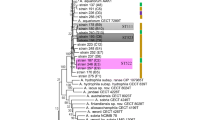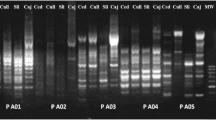Abstract
Sixty-three Paracoccidioides brasiliensis isolates obtained from three nine-banded armadillos ( Dasypus novemcinctus), one Amazonian armadillo's and 19 clinical isolates were compared by random amplified polymorphic DNA analysis with the primer OPG-19. The isolates were divided into three major clusters, I, II and III. Coincidences between human and armadillo isolates were observed in clusters I and II. Cluster III consisted only of armadillos' isolates. The results suggested that (I) humans may acquire P. brasiliensis infection by contact with armadillo's environment, (II) there may be P. brasiliensis genotypes peculiar to the animal, and (III) individual armadillos may be infected with P. brasiliensis cells with different genotypes.
Similar content being viewed by others
References
Restrepo AM. The ecology of Paracoccidioides brasiliensis: a puzzle still unsolved. J Med Vet Mycol 1985; 23: 323‐334.
San-Blas G. Paracoccidioidomycosis and its etiologic agent Paracoccidioides brasiliensis. J Med Vet Mycol 1993; 31: 99‐113.
Albornoz MB. Isolation of Paracoccidioides brasiliensis from rural soil in Venezuela. Sabouraudia 1971; 9: 248‐253.
Ferreira MS, Freitas C, Lacaz CS, Del Negro GMB, Melo NT, Garcia NM, Assia CM, Salebian A, Heins-Vaccari EM. Isolation and characterization of a Paracoccidioides brasiliensis strain from a dogfood probably contaminated with soil in Uberlandia, Brazil. J Med Vet Mycol 1990; 28: 253‐256.
Negroni P. El Paracoccidioides brasiliensis vive saprofiticamente en el suelo argentino. Prensa Med Argentina 1966; 53: 2831‐2832.
Brummer E, Castaneda E, Restrepo A. Paracoccidioidomycosis: an update. Clin Microbiol Rev 1993; 6: 89‐117.
Naiff RD, Ferreira LCL, Barrett TV, Naiff MF, Arias JR. Paracoccidioidomicose enzoótica em tatus (Dasypus novemcinctus) no estado do Pará. Rev Inst Med Trop S Paulo 1986; 79: 765‐772.
Restrepo A. Actualizacion sobre la paracoccidioidomicosis y su agente etiologico, 1986‐1989. Interciencia 1990; 15: 193‐199.
Camargo GP, Taborda CP. Antigenic relationship between Paracoccidioides brasiliensis isolated from faeces of penguin and a human isolate of P. brasiliensis. J Med Vet Mycol 1993; 31: 347‐352.
Grose E. Paracoccidioides brasiliensis recovered from the intestinal tracts of three bats (Artibeus lituratus) in Colombia S.A. Sabouraudia 1965; 4: 124‐125.
Bagagli E, Sano A, Coelho KIR, Alquati S, Miyaji M, Camargo ZP, Gomes GM, Franco M, Montenegro MR. Isolation of Paracoccidioides brasiliensis from armadillos (Dasypus novemcinctus) captured in an endemic area of paracoccidioidomycosis. Amer J Trop Med Hyg 1998; 58: 505‐512.
Yamamoto Y, Kohno S, Koga H, Kaneya H, Tomono K, Kaku M, Yamazaki T, Arisawa M, Hara K. Random amplified polymorphic DNA analysis of clinically and environmentally isolated Cryptococcus neoformans in Nagasaki. J Clin Microbiol 1995; 33: 3328‐3332.
Soares CMA, Mollinari Madlun EEWI, DA Silva SP, Pereira M, Felipe MSS. Characterization of Paracoccidioides brasiliensis isolates by random amplified polymorphic DNA analysis. J Clin Microbiol 1995; 33: 505‐507.
Verweji PE, Meis JFG, Sarfati J, Hoogkamp-Korstanje JAA, Latgè JP, Melchers WJG. Genotypic characterization of sequential Aspergillus fumigatus isolates from patients with cystic fibrosis. J Clin Microbiol 1996; 34: 2595‐2597.
Denning DW, Shankland GS, Stevens DA. DNA fingerprinting of Aspergillus fumigatus isolates from patients with aspergilloma. J Med Vet Mycol 1991; 29: 339‐342.
Haynes KA, Sullivan DJ, Coleman DC, Clarke JCK, Emilianus R, Atkinson C, Cann KJ. Involvement of multiple Cryptococcus neoformans strains in a single episode of cryptococcosis and reinfection with novel strains in recurrent infection demonstrated by random amplification of polymorphic DNA and DNA fingerprinting. J Clin Microbiol 1995; 33: 99‐102.
Redding SW, Pfaller MA, Messer SA, Smith JA, Prows J, Bradley LL, Fothergill AW, Rinaldi MG. Variations in fluconazole susceptibility and DNA subtyping of multiple Candida albicans colonies from patients with AIDS and oral candidiasis suffering one or more episodes of infection. J Clin Microbiol 1997; 35: 1761‐1765.
Author information
Authors and Affiliations
Rights and permissions
About this article
Cite this article
Sano, A., Tanaka, R., Yokoyama, K. et al. Comparison between human and armadillo Paracoccidioides brasiliensis isolates by random amplified polymorphic DNA analysis. Mycopathologia 143, 165–169 (1998). https://doi.org/10.1023/A:1006949113529
Issue Date:
DOI: https://doi.org/10.1023/A:1006949113529




